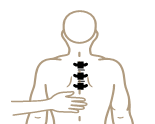Jane is a lively, active woman with a demanding, stressful job that involves a lot of computer work. She had previously had 15 lessons with me some years ago for upper back pain. This had been caused by a wrench to the shoulder when the bus on which she was traveling braked sharply while she was holding on to a handrail. This had been investigated by her GP and hospital. She had received a course of physiotherapy but the pain remained. Also, at that time, she had a motorbike accident that injured her right knee causing inflammation.
In Jane’s own words:
By the end of the course of lessons the pain had gone completely from my back. One lesson was spent concentrating on the knee injury and following this I remained pain-free for five years.”
She resumed lessons with me seven years later because of severe pain in her right shoulder. The pain was concentrated across the collarbone and restricted movement of her arm. The pain was dull on resting and sharp on movement. The pain had been recurring for the last 3 months, was constant for about 2 – 3 days and would recommence after a 2 – 3-day interval. The inflammation of her knee had also returned.
First lesson
Jane could remember her previous lessons although she had not maintained her practice. Placing my hands on her I found her shoulders were pulled forward and down with muscular tension, also her neck muscles were contracting when moving, e.g. sit to stand. In addition, I found there was considerable tension in her legs. The immediate problem was to help Jane improve the tension of her neck and shoulders in the movement to prevent further inflammation.
Working with my hands to give Jane the experience of what I was saying, I reintroduced her to the fundamental concepts of Alexander Technique such as primary control (how the relationship between the head, neck, and back affects poised, co-ordinated action and is activated by non-doing or ‘inhibitory’ thought). Using a light touch, without mechanical force, plus verbal instruction, I showed Jane how to activate the support and balance mechanisms of the body. I was able to demonstrate to her how she could allow her shoulders to ‘float’.
I gave Jane lesson guides and information on ‘semi-supine’ for her to practice on a daily basis between her appointments. The principle of ‘semi-supine’ is that by supporting the body on a flat firm surface, the muscles not only release but the shape of the body changes.
Subsequent lessons
Practicing semi-supine increased Jane’s sensory awareness and constructive thought, which gave her a good use of primary control and the support and balance mechanisms of the body. Using this as the context in which further release could take place, I was then able to work with gentle guidance from my hands and with verbal instruction to obtain release from the large movement muscles of the shoulder and arm, allowing the shoulders to be free. When the drag of the arm and shoulder girdle was lifted, the brachial plexus no longer impinged.
While working for further release of tension, I also looked at how Jane was sitting at her desk and using her computer and mouse. I noticed that there was undue muscular activity in her legs while she was sitting. I started to include more work on how she can release her legs by encouraging her self observation.
Further lessons included more practical activities such as driving and Jane’s posture while using the PC. I continued to introduce work (using my hands coupled with practical activities) to increase Jane’s perception of inappropriate muscular activity so that she became aware of how she was affecting her knee.
“The shoulder improved from the first lesson, and after three lessons the pain had gone. This time I have learned more about the large muscles across the front of the shoulder and the back that affect the movement of the shoulder and arm and this has had a definite impact. I am now back to typing 70wpm!!”
Jane (after her fifth Alexander Technique lesson).
